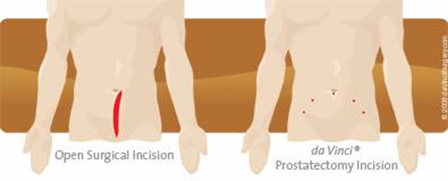Robotic Assisted Laparoscopic Prostatectomy
About
Prostatectomy is the surgical removal of the prostate gland as a treatment for prostate cancer. To do this we now use a surgical robot called the Da Vinci to facilitate this. This enables us to do complex laparoscopic or “key hole” surgery as opposed to the traditional open surgery.
The robot is controlled by the surgeon at all times and doesn’t work independently. The robot is connected to the patient and very small instruments are inserted through key holes in the abdominal wall. The surgeon sits at a separate console and does the operation without touching the patient. The surgeon has complete control of the robot at all times.
Kent and Canterbury is the first hospital in South East England, outside of London, to offer this advanced treatment option.
Is the surgeon able to do the same operation with the robot?
Yes.
In terms of cancer treatment it is regarded as the same as open surgery and doesn’t compromise cancer control.
What are the advantages of robotic surgery?
This type of surgery offers many advantages for the surgeon and for the patient.
- Highly magnified high definition view of operation
- Complete 3D view
- Much finer more delicate dissection
- Far more precise surgery
- Abolishes tremor

- Lower complication rate
- Lower infection rate
- Less pain
- Quicker recovery
- Shorter hospital stay
- Shorter catheter time
- Less blood loss and a lower rate of needing a blood transfusion (1%)
- Earlier return to work/normal daily activities
- Improved cosmetic result
Are there any complications of this surgery?
- Bruising in the scrotum or around the wounds
- Bladder spasms/pain with catheter
- Constipation – this is important to avoid and you will be given medication for this
- Blood in the urine
- Urinary or wound infection
- Facial swelling lasting a few hours
- Shoulder pain lasting a few hours
- Bleeding requiring transfusion or need to return to theatres (1%)
- Damage to structures around the prostate i.e. bowel/rectum/bladder/blood vessels or ureters (tubes between kidney and bladder) (<1%)
- Risk of clots in the legs(DVT) or clots on the lungs(PE) (1%). You will have injections to reduce this problem. Keeping well hydrated and early mobilisation/walking helps prevent this problem.
- Medical complications such as chest infections or MI(<1%)
- Conversion to an open operation – again this is rare at around 1%
- Incontinence
- Continence can be affected by this treatment however longterm(longer than a year) incontinence that requires further surgical treatment is around 2%. Majority of patients will have some degree of incontinence when the catheter is removed and may need to use pads for a period of time. With robotic surgery continence recovers quicker. It is important to do your pelvic floor exercises before during and after your recovery.
- Erectile dysfunction
- Erections can be affected by this surgery, this is more likely in older patients and if you have weak erections before the surgery. In patients who want to keep their erections we can offer “nerve spare” surgery. This is part of the operation where we protect the nerves that go down to the penis, these run very close to the prostate and can be gently peeled off. We don’t offer this in patients with more advanced disease. Even with nerve spare surgery erections are not guaranteed. You will be given a daily tablet to help the erections recover, in some men this can take between 1 year and 18 months.
Are there any alternatives to this treatment?
Yes. These should have been discussed with you by your Urologist or Oncologist. Depending on your age, PSA, type of disease and other health issues, radiotherapy, brachytherapy, surveillance or hormone therapy are all treatment options. However this type of surgery is only chosen if we feel it’s the most appropriate treatment option for you.
Can the robot breakdown?
Potentially although this is a very rare scenario(<0.5%). If this happens either the operation can be rescheduled or the operation is done as an open operation. Over 4000 robots are being used worldwide and this has only been reported in a handful of cases.
How long does the operation take?
Around 2 hours. It is done under general anaesthetic, and you will wake up in the recovery bay before being transferred back to the ward. Operation times can vary depending on various factors such as obesity, size of Prostate and previous abdominal surgery.
What happens from now?
Once we have decided on robotic surgery you will be contacted with a date for the operation. You will be asked to attend the pre-assessment clinic where routine bloods and ECG are taken and an assessment of your fitness for surgery is made.
You will then be admitted to the hospital on the morning of the operation, where you will meet the surgeon, the anaesthetist and the nursing staff. You will be asked to sign the consent form. You will have one enema administered before the operation.
After surgery
Results
How do we improve our service?
We are constantly trying to improve the high quality care we provide. We continually audit and assess our results. We will ask you to fill out questionnaires on incontinence, erectile dysfunction and overall quality of life. We would like you to fill these out before the operation and at all your follow up appointments. We also want to you to record the first day you manage without pads and when you return to work. Please let us know these dates at follow up or by email.
All this information is handled anonymously, and is collected on all patients. Please feel free to add any other comments whether good or bad. All these comments will be taken seriously and will be used to improve the system further.
